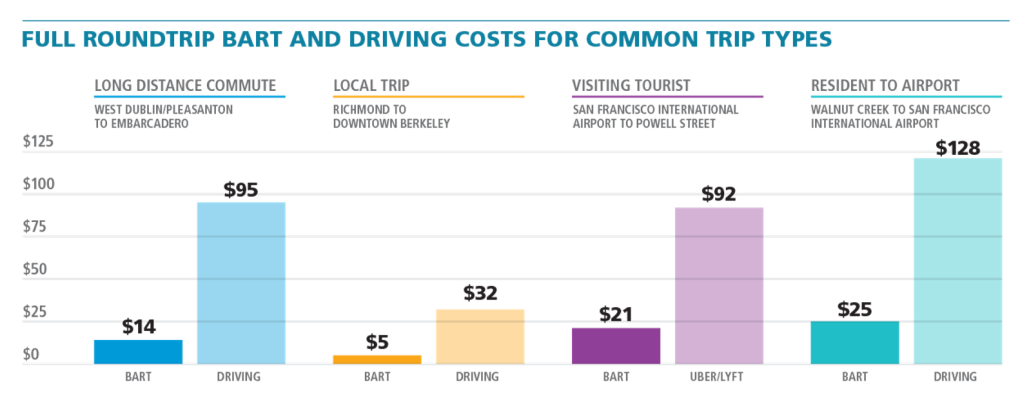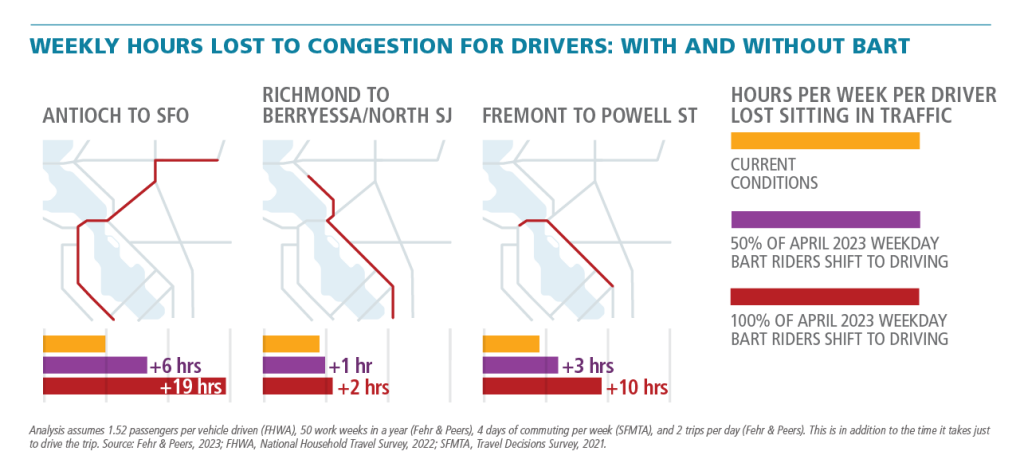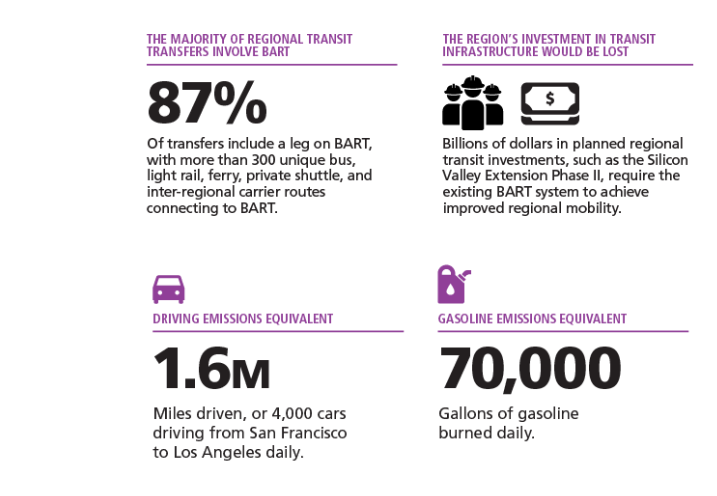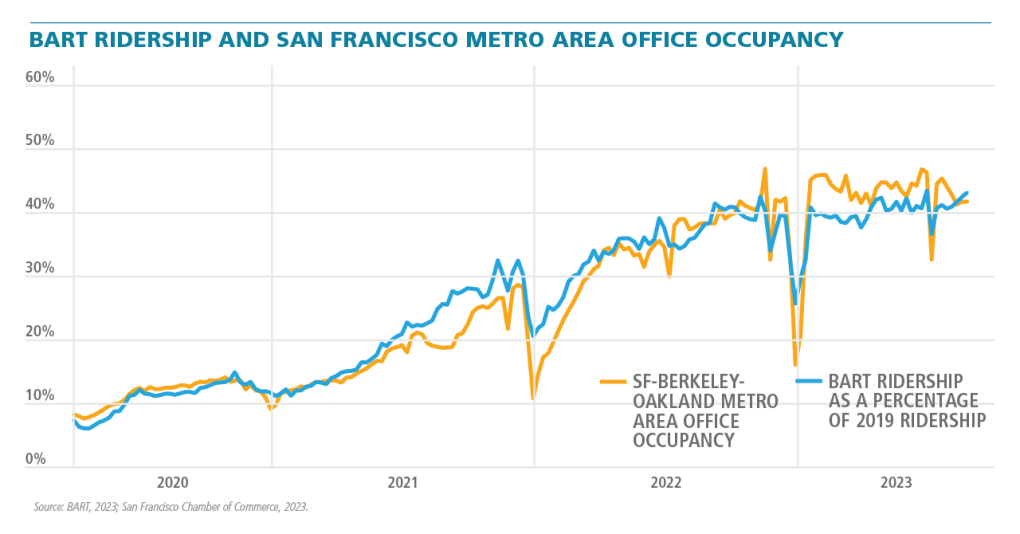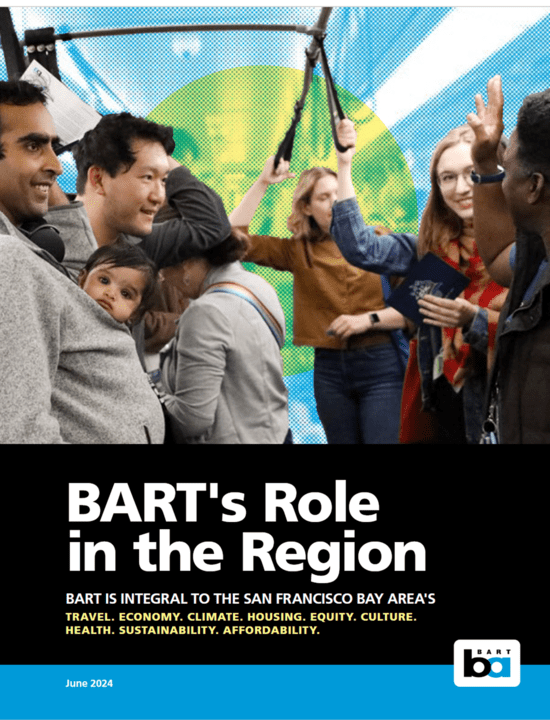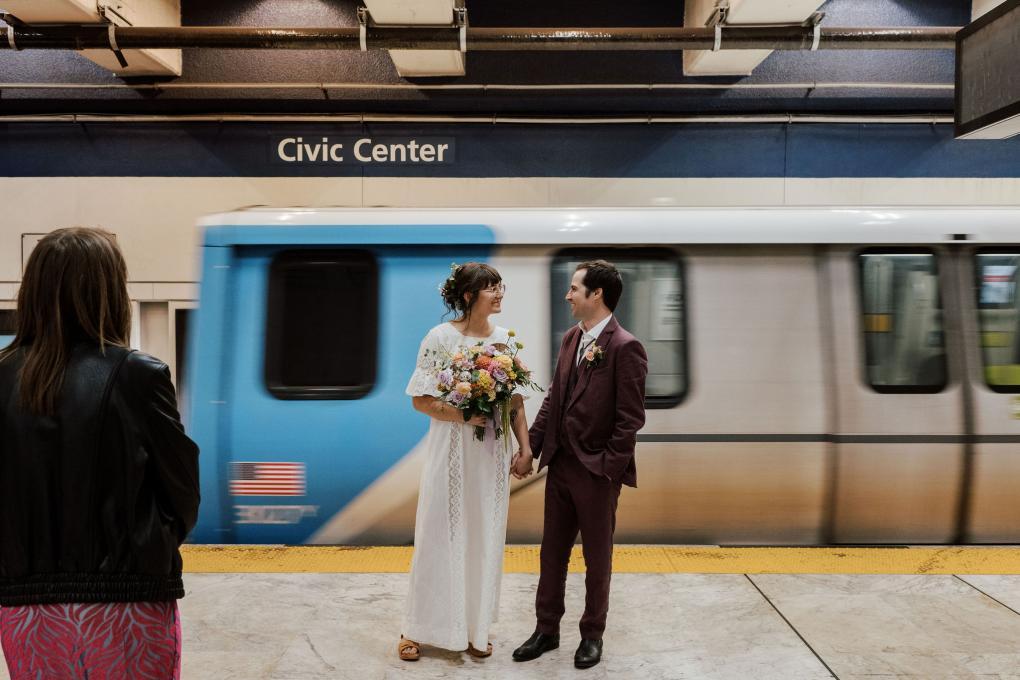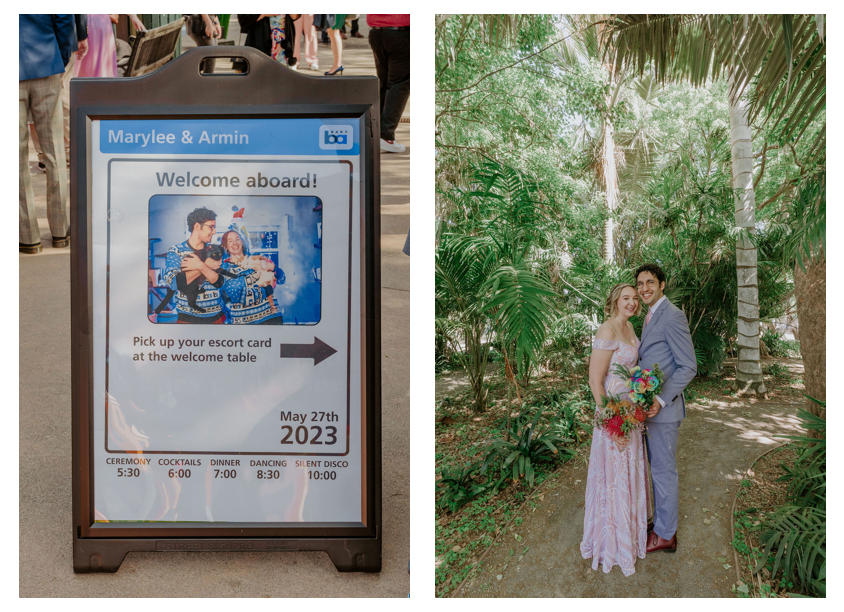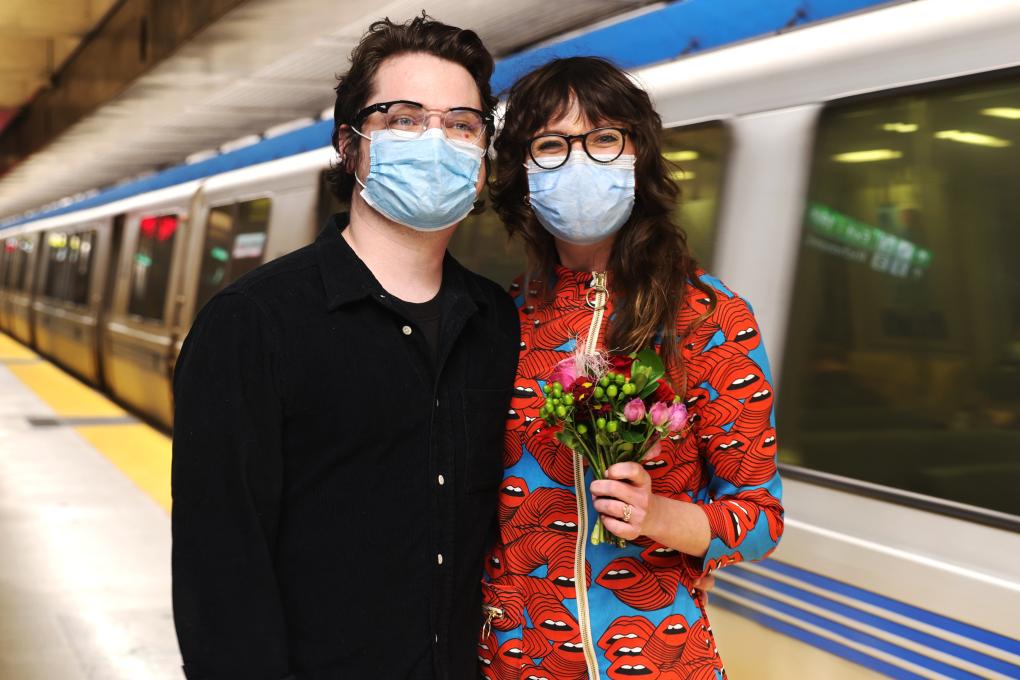Search Results
Podcast: Go inside BART's version of mission control
In this latest edition of our podcast series “Hidden Tracks: Stories from BART” we take you behind the scenes of the Operations Control Center. The OCC is the nerve center of the BART system. This is where a dedicated team of problem solvers oversees BART’s critical infrastructure as well as all of the trains
BART’s “Role in the Region” detailed in new report that describes the benefits of BART and the devastating impacts of a Bay Area without it
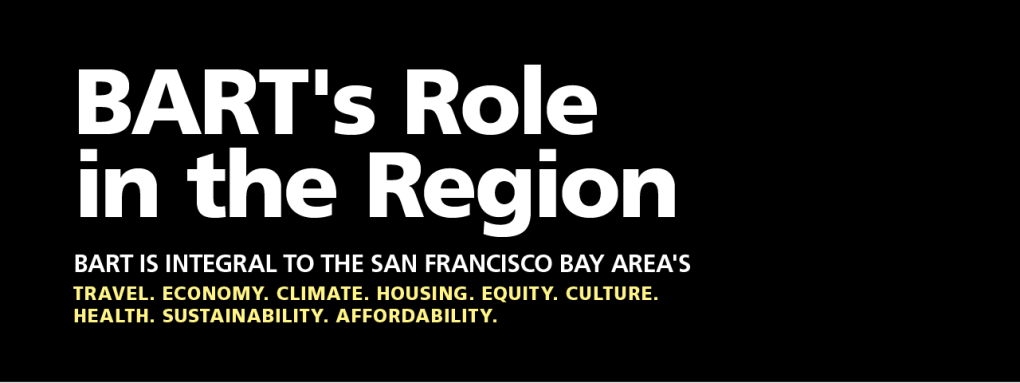
A new report released today paints a bleak picture of a Bay Area without BART while highlighting the benefits of the transit system to the region with a wide range of metrics.
Click here to view a pdf of the report and visit the project webpage at bart.gov/roleintheregion.
BART's Role in the Region Report aims to inform a regional conversation about the future of BART by describing its contributions to the Bay Area. It also provides predictions for how the Bay Area – its economic viability, traffic-choked roadways, cultural institutions, and more – will look without BART.
“The Bay Area and our regional transportation network have undergone significant changes since BART last conducted a Role in the Region study in 2016," said BART General Manager Bob Powers. “The 2024 Role in the Region Report arrives at a crucial crossroads for BART and the region, and the data, analyses, and stories within will serve as an important educational resource for the pivotal years ahead.”
In the report, you will find insights into key topics, including changes in travel patterns and funding; BART’s holistic benefits to the Bay Area; and BART’s future.
Below is a snapshot of some of the report’s findings:
BART’s benefits:
- BART is significantly more affordable than driving (Fig. 1 in slideshow). Example: Taking BART from West Dublin/Pleasanton Station to Embarcadero Station roundtrip costs $14. Driving the same route costs $95 when accounting for gas, tolls, parking, insurance, and maintenance.
- BART is integral to a connected regional transit network. Within a 15-minute walk of BART and one transfer to a connecting agency transit stop, you can reach 67% of the 9-county Bay Area region’s jobs, 61% of the region’s residents, and 60% of schools, parks, and libraries.
- In 2023, BART contributed $1.2 billion to the economy through more than 5,000 jobs when accounting for BART’s direct payroll expenditures, local vendor spending, and employee expenditures. Between 2019 and 2023, BART infused the local economy with more than $3.7 billion in construction spending and $1.7 billion in construction labor income.
If BART did not exist:
- Regional traffic congestion would worsen. Example: Drivers could experience up to an additional 19 hours lost to congestion weekly (Fig. 2).
- Traffic could increase by 73% on the Bay Bridge and 22% in the Caldecott Tunnel during morning peak commute hours.
- The regional transit network would fail to function, and there would be cascading effects across the 300 bus, light rail, ferry, private shuttle, and inter-regional routes that connect to BART (Fig. 3).
Changing regional travel trends:
- BART ridership is closely linked to regional office occupancy rates; both have recovered to ~43% of pre-pandemic levels (Fig. 4).
- Because of BART’s decreased farebox recovery, BART expects a budget deficit beginning in 2026 when state and federal emergency assistance runs out.
View the full Role in the Region Report.
Recent measles exposure on BART; risk of infection low
Some BART riders may have been exposed to measles last week after a San Mateo County resident with measles commuted from Millbrae station to Civic Center station while infectious. The risk of contracting measles via BART is negligible, though Bay Area residents should be aware of the situation. San Mateo
Officer training exercises at Millbrae BART Station May 3 and 6
From 10 am to 3 pm on Tuesday, May 3, and Friday, May 6, BART Police will assist the San Mateo County Sheriff’s Department with training exercises at Millbrae Station. SamTrans is providing a bus for the exercises that will be parked in the surface parking lot. BART will have a train parked at the out-of
BART cosponsors Oakland Lunar New Year celebration
BART is teaming up with the County of Alameda, the Asian Community Collaborative and the Oakland Asian Cultural Center to cosponsor the annual Lunar New Year Celebration in Oakland. This year’s festivities will be held Thursday, February 19, from 11:45 a.m. to 1:30 p.m. at the Oakland Asian Cultural Center
On Valentine’s Day, BART to host first-ever speed dating/friend making event on a moving BART train
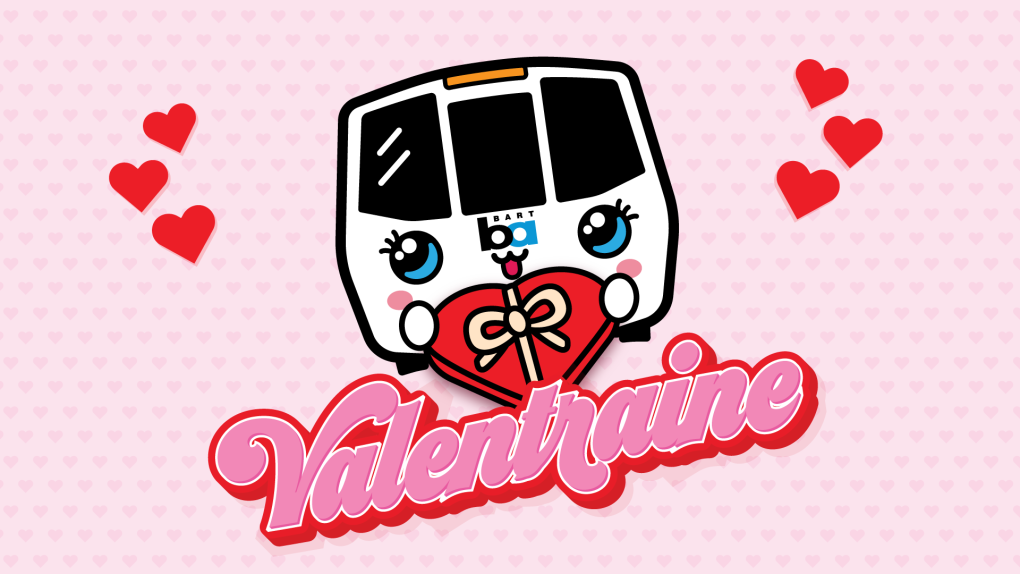
This Valentine’s Day, hop on the Valentraine and ride your way to love or friendship.
On the evening of Friday, Feb. 14, BART invites adults ages 18 to 35 to join us for an on-the-rails mixer aboard a moving BART train. Ride BART into someone’s heart on a special train reserved just for this event!
It’s time to get off the apps and get on Trainder. This is speed dating – literally.
We’ll help grease the wheels with icebreaker activities, conversation starters, a raffle, and BART-themed Valentines that you can give to potential connections.
Adults of all sexual orientations are welcome as are those looking to make friends rather than find romance. We will have name tags with a space to write in what you are looking for. Participants must be ages 18 to 35 (we’ll explore hosting a similar event for those 35+ in the future).
What: BART speed dating/friend making
When: Friday, Feb. 14, 6:30pm to approx. 8:35pm
Where: Start at Downtown Berkeley Station and ride to 24th St./Mission before returning to Downtown Berkeley. The train will not stop for the duration of the ride.
Who: Adults ages 18 to 35 of all sexual orientations looking for love and/or friendship
RSVP Required: bartspeeddating.eventbrite.com
RSVPing via the Evenbrite link above is a requirement for participation, and registration is limited. The e-ticket you receive from Eventbrite is NOT your BART fare. Every participant must have a Clipper card – make sure you have at least $7.10 (BART’s excursion fare) on your card.
Here’s how things will go:
- Arrive at Downtown Berkeley Station no later than 6:30pm for check-in. Late arrivals will not be allowed onboard. We will meet inside the station on the concourse level under the rotunda. Look for BART staff with signage.
- Depart Downtown Berkeley at 7:10pm.
- We’ll ride the Red Line to 24th St./Mission, where the train will turn around and head back to Downtown Berkeley. The train will not make stops for the duration of the ride.
- Arrive at Downtown Berkeley Station at approx. 8:35pm.
- If you plan to park and ride, we suggest parking in the lot at Ashby Station (one stop up the line) and ride BART to Downtown Berkeley. There are also multiple parking lots and limited street parking near the station.
There will be additional staff and safety presence on each train car. BART has a zero-tolerance policy for sexual and gender-based harassment, consuming alcoholic beverages and illicit substances, and engaging in disruptive/disturbing behavior in our trains and stations. Read the full Customer Code of Conduct here. Violators will be removed from the train and face potential disciplinary action.
BART is experimenting with hosting events on trains such as this speed dating/friend making mixer as a way to engage our community, spur connections, and encourage riding BART. We’ve heard so many stories of people meeting partners and friends onboard, as well as those who’ve taken a train to get married. We hope this event will generate even more stories! Find links to a selection of these articles below.
Read the couples' stories:
A transit wedding happened naturally for these newlyweds
Former BART attorney met the love of her life on San Francisco-bound train
Couple who met on BART tie the knot with whimsical BART-themed wedding at Fairyland
"Good vibes on the train": BART employee takes BART to wedding ceremony at San Francisco City Hall
“BART Guy” and “BART Girl” finds love on an empty Embarcadero platform
BART Connects: Why Eric’s students at the Orientation Center for the Blind ‘fall in love’ with BART when they come to the Bay
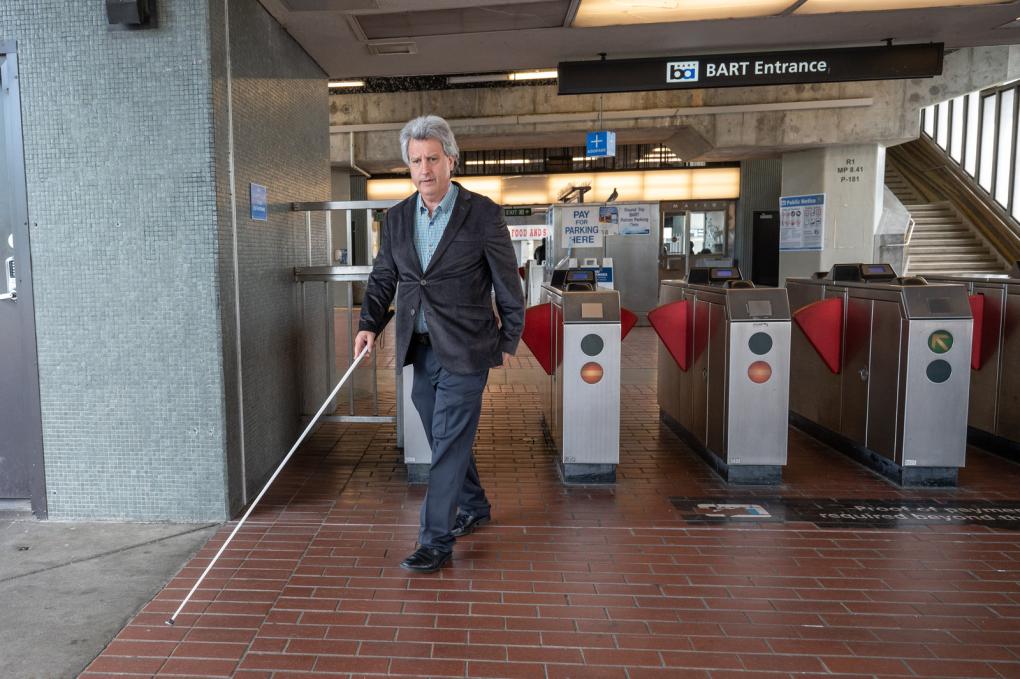
Eric Mazariego navigates El Cerrito Plaza Station.
BART is developing detailed descriptions of station tactile guideways, a navigation system for riders who are blind and low vision that leads to bus bays, fare gates, and platform stairs. Find the descriptions here and read the story of their development here.
Eric Mazariegos has been taking BART “forever.”
His earliest BART memory is riding trains to eye doctor appointments in San Francisco with his mom. He was eight years old when he started losing his vision, and it took doctors two years to figure out what was happening. That meant lots of appointments – and lots of BART.
Those long BART rides from his home in Concord to San Francisco and back turned out to be a useful educational tool as his vision loss continued.
“I rode it so much as a kid, I’d memorized a lot of the stations,” he said. “I had a head start [for navigating the system without vision].”
Later in life, he began taking BART regularly, first to get to class at San Francisco State, then a job in Fremont, and now to his current workplace, the Orientation Center for the Blind (OCB).
“It’s my primary mode of transportation,” he said. Rideshares fill in the blanks when necessary (though BART is always his first choice).
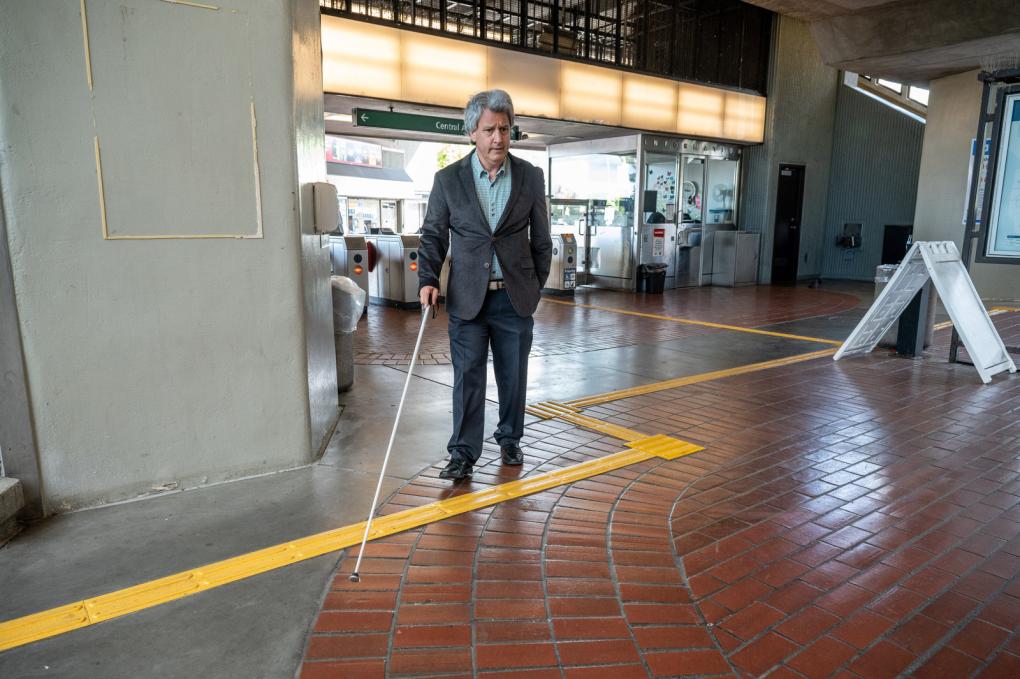
Eric uses his white cane to follow the tactile guideway at El Cerrito Plaza.
When Eric navigates a BART station, he is listening to the sounds around him and translating the tactile clues from his white cane to the spatial map in his mind.
Every BART station has a unique soundscape and tactile geography that allows Eric to make his way through a station and onto a BART train.
“I listen for the turnstile, so I know where to enter. I feel for the carpets near the escalators – a clue that I’m almost there. I hear my cane on the metal landing platform. Then I ascend to the platform,” Eric said, describing some of the cues he uses to navigate a station without vision. When he reaches the platform, there are other guide tools – bumpy tactile guideways that signal you are nearing the trackway, speakers announcing the approach of trains.
Part of Eric’s job is to support people like him -- people who are blind or low vision -- in learning to move around their cities and regions.
Eric serves as the Administrator of OCB, a 60-year-old residential training program run by the Department of Rehabilitation (DOR) that provides free on-site training to job seekers who are visually impaired and blind. Said Eric: “The mission of the DOR is everyone who wants to work can work.”
Eric started at OCB as a dorm counselor in 1999. Twenty-five years later, he’s overseeing the organization’s entire staff of 35. To get to OCB from his home in Concord, Eric takes BART, twice a day, five days a week. Without it, his travel options would be extremely limited.
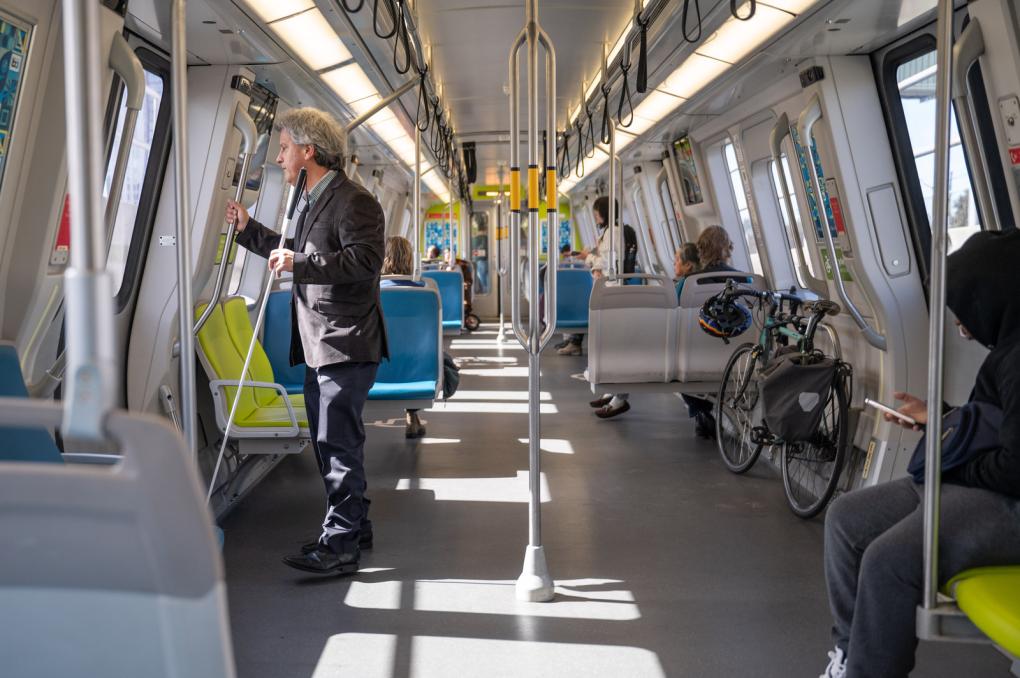
Eric stands on a BART train.
The OCB campus is about a half mile from El Cerrito Plaza Station. Every day of the week, you’ll see OCB participants on campus going to and from classes, which include courses such as Daily Living Skills, Cooking, Braille, Adaptive Technology training, and independent travel. Some students are new to blindness. Some come from outside of the Bay Area. Many live on campus through the duration of their training course.
“I’d have to find a job closer to my house,” he said. “BART opens up the possibilities to work wherever you want, and your job is a huge part of your life. A lot of people take that for granted.”
There’s a learning curve for OCB students ready to set out on their own via public transportation. First, they must learn white cane skills so they can detect obstacles and pathways and safely orient themselves in spaces they haven’t experienced before.
Teachers provide hands-on guidance and “BART field trips” to show students how to confidently navigate the system, and they have tactile maps of some stations so they can get a sense of their layouts. Many students want to go out and learn by experiencing it for themselves.
“When students advance to the point of being able to use BART, they love it. It’s so freeing because it takes you everywhere, runs frequently, and is dependable,” Eric said. “A lot of our students come from Southern California, and they’re not used to having great transit. Many don’t like going back home because they fall in love with our transportation system.”
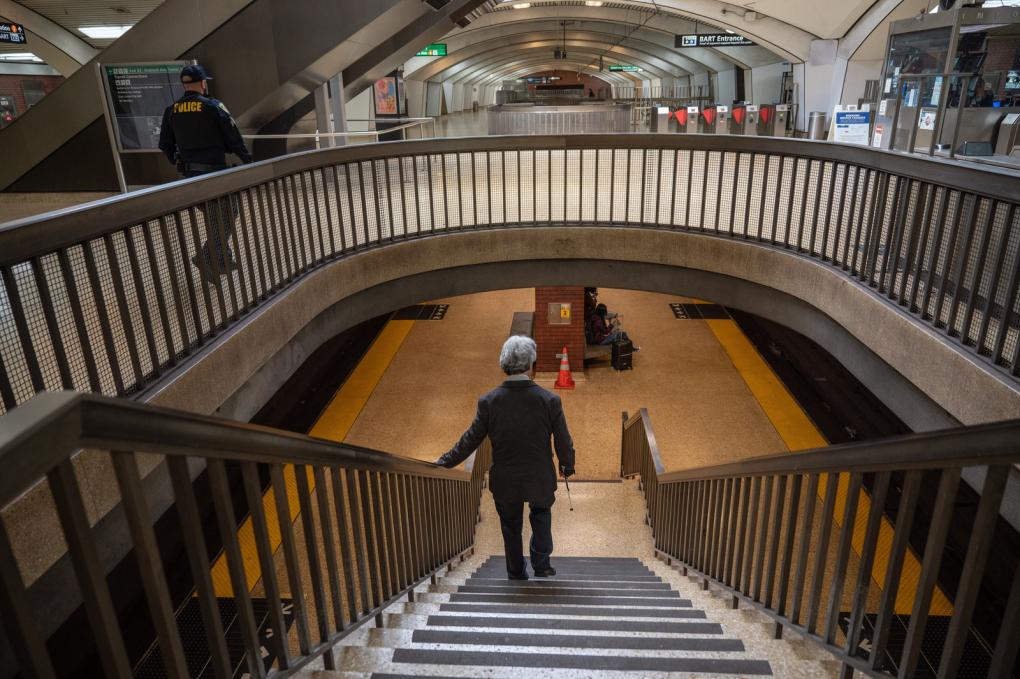
Eric enters Downtown Berkeley Station's platform via the stairs.
About BART Connects
The BART Connects storytelling series was launched in 2023 to showcase the real people who ride and rely on BART and illustrate the manifold ways the system affects their lives. The subjects of BART Connects will be featured in videos as well as a forthcoming marketing campaign that is slated to run across the Bay Area. Find all the stories at bart.gov/bartconnects.
The series grew out of BART's Role in the Region Study, which demonstrates BART’s importance to the Bay Area’s mobility, cultural diversity, environmental and economic sustainability. We conducted a call for stories to hear from our riders and understand what BART means to them. More than 300 riders responded, and a selection of respondents were interviewed for the BART Connects series.
BART Connects: A working mom remembers when her only downtime each day was her BART ride
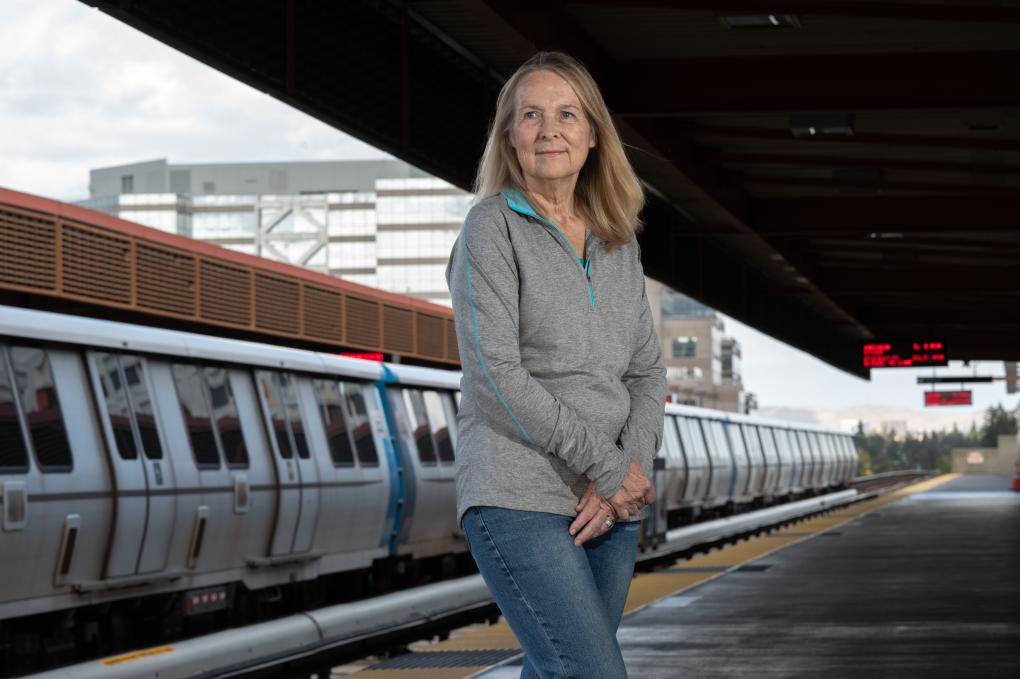
Linda Healey pictured at Walnut Creek Station.
Do you have a favorite BART memory or story to share? Email a short summary to BART Storyteller Michelle Robertson at [email protected], and she may follow up to schedule an interview.
Linda Healey took BART to work for more than twenty years. When her son was young, those daily BART rides were her only downtime in the day.
“BART got me home to my child quickly,” she said. “And it got me home unstressed because I could relax, rather than sit in traffic. That was a gift.”
Now retired, Healey still looks back on her BART commute fondly. Each morning, Healey would walk about ten minutes from her home to Walnut Creek Station, where she’d board a San Francisco-bound train.
During the ride, she finally had a few minutes time to read, and she treasured that time. She alternated between the classics and pure “pleasure reading,” from Finnegan’s Wake to Agatha Christie. Thirty minutes or so later, she’d disembark at one of the Market Street stations in San Francisco and head to work for the day at a large financial institution.
Healey still takes BART to those same stations, but nowadays, her destination is mostly dinner or the theatre, a lifelong passion of hers. In the eighties, she said she took BART to see the original touring casts of classics like Cats, Phantom of the Opera, and Les Misérables. She’s especially grateful for BART’s Senior Clipper card, which gets her 62.5% off her fare.
One of Healey’s most treasured BART memories doesn’t involve her commute or theatergoing. Eleven years ago, she met a 21-year-old Italian woman on a train who was traveling alone. Her name was Stefania, and she couldn’t remember which station she was supposed to meet her aunt at, but knew she lived in Danville. Healey suspected Walnut Creek was their meeting place.
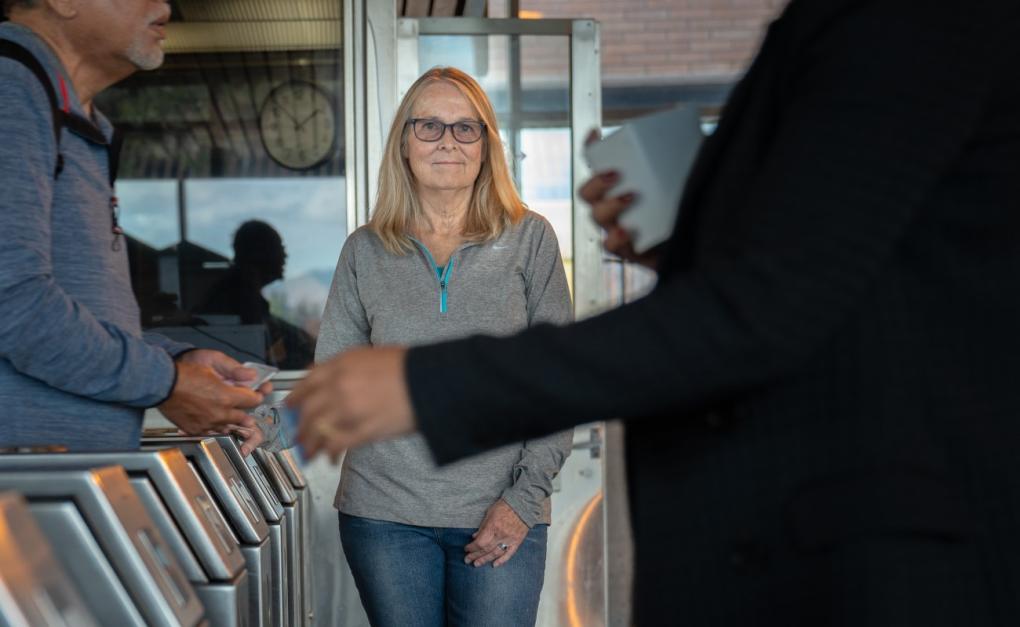
The two women struck up a conversation, and Healey learned Stefania lived in Lucca, Tuscany, and was staying with her aunt for 29 days to practice her English. Healey was charmed by her wit and “beautiful Italian accent.” They chatted the entire way.
When they got to Walnut Creek Station, Healey made Stefania a deal. She would walk home, wait a few minutes, and then return to the station in her car to make sure Stefania had been picked up. Healey told her, “If you’re still there when I get back, I’ll drive you to your aunt’s place.” She returned a half hour later, but Stefania was nowhere to be found.
The two women kept up a correspondence, with Healey sometimes helping Stefania with her English class homework. In the decade since, Healey has watched Stefania fall in love, get married, and have a child. She sends Healey baby pictures now. Healey hopes to meet the family in Italy one day.
“We were at such different points in our lives,” Healey said. “But we just hit it off on BART. It never would have happened if it weren’t for that train ride. I really scored.”
Healey intends to visit Stefania in Tuscany in the near future. She’ll take BART to the airport, as she always does.
Today, Healey’s son – now in his thirties and living in Oakland – does the same commute his mother did for so many years, though he hops on the train a few stops up the line. He even works for the same company.
“I passed the BART baton to him,” Healey said. “Hopefully one day, he’ll get to take it just for fun.”
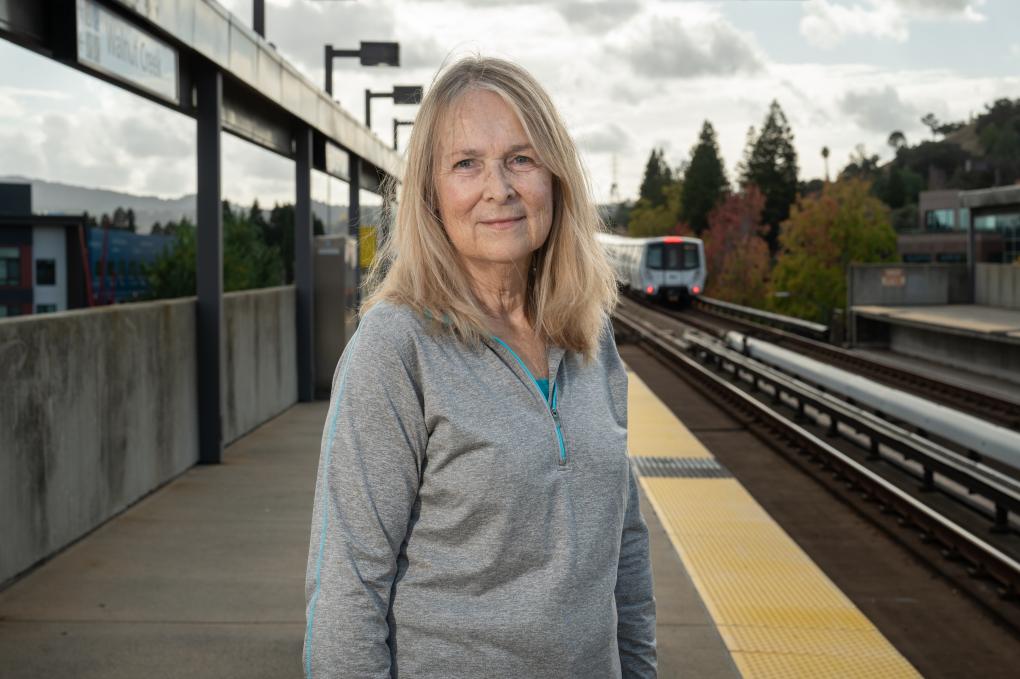
About the BART Connects Storytelling Series
The BART Connects storytelling series was launched in 2023 to showcase the real people who ride and rely on BART and illustrate the manifold ways the system affects their lives. You can follow the ongoing series at bart.gov/news.
The series grew out of BART's Role in the Region Study, which demonstrates BART’s importance to the Bay Area’s mobility, cultural diversity, environmental and economic sustainability. We conducted a call for stories to hear from our riders and understand what BART means to them. The call was publicized on our website, social media, email blasts, and flyering at stations. More than 300 riders responded, and a selection of respondents who opted-in were interviewed for the BART Connects series.
BART Board approves $675 million balanced budget
Budget funds record ridership on aging system BART's budget for the upcoming fiscal year allows the agency to provide an unprecedented level of service to a record number of riders on an ever aging fleet and infrastructure. The BART Board of Directors unanimously approved a $674.8 million Fiscal Year 2009
Changes to DBE Federal Regulations/BART DBE Program
Effective March 1, 2023, the statutory gross receipts cap for certified DBEs specified in 49 CFR §26.65 has been adjusted for inflation from $28.48 million to $30.40 million. This adjustment applies to the DBE program only, therefore, is also applicable to firms who apply for the District’s Small Business
